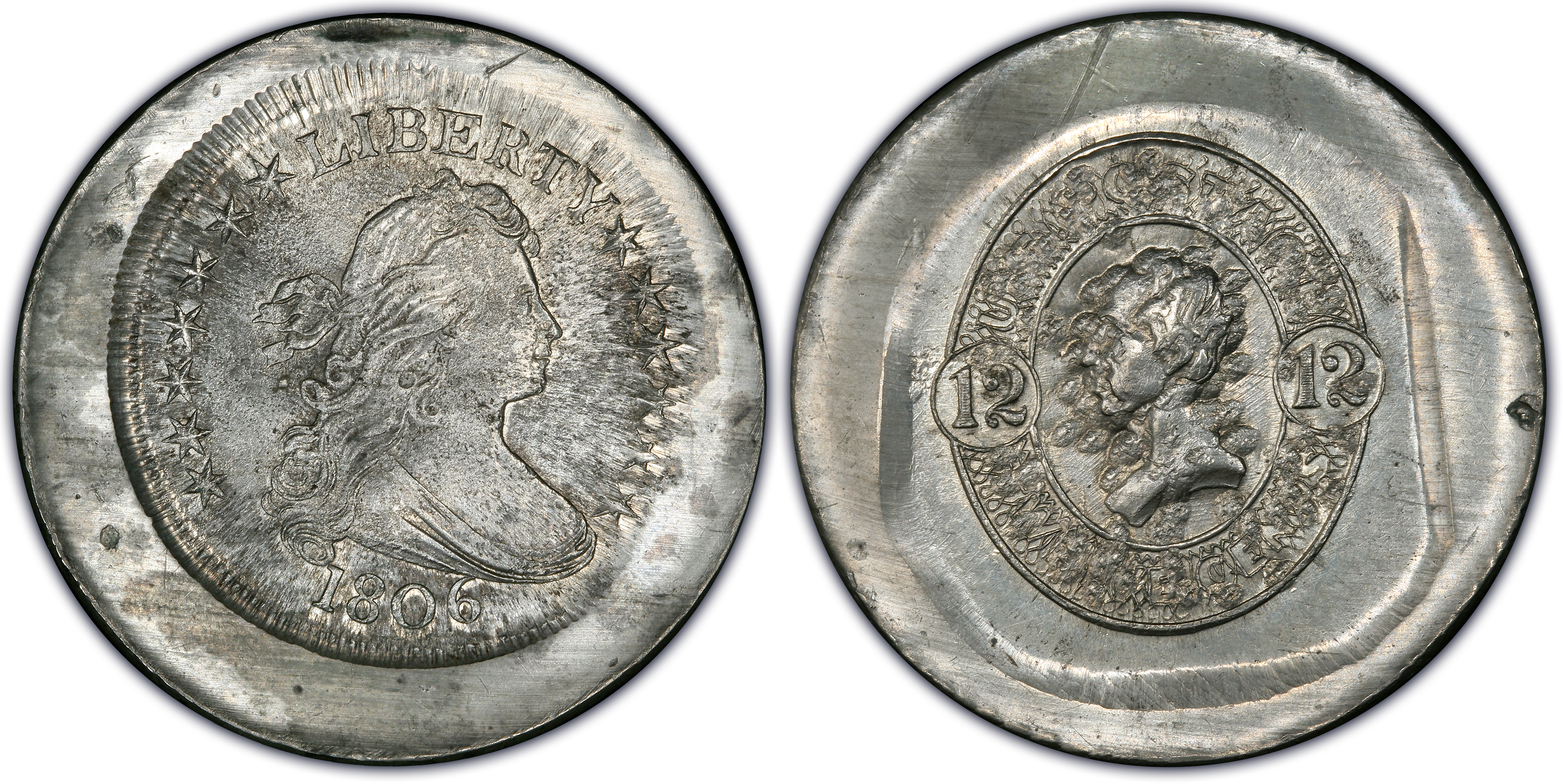1806 Half Dollar Restrike
Just ran across restrikes of the 1806 half dollar attributed to David Proskey by Abe Kosoff. The die is now in the collection of the American Numismatic Society.
Has there been any recent information to confirm if these were struck by David Proskey, or someone else?
1806 50C Judd-A1806-1, Pollock-6150, R.7, NGC MS65
This one sold in the EPN collection in 2017 for $10,800.00.
- https://nnp.wustl.edu/library/ImageDetail/558308
- https://coins.ha.com/itm/early-half-dollars/half-dollars/1806-dt50c-half-dollar-private-restrike-j-a1806-1-r7-ms65-ngc-overton-obverse-11/a/1260-15092.s?ic4=GalleryView-Thumbnail-071515
It's amazing that Eric Newman purchased this for $20. The envelope from HA is below.


Some of these are struck paired with an embossing die for a 12-cent stamp that features a portrait of Henry Clay such as the following:
1806 50C Judd-A1806-1, Pollock-6150, R.7, PCGS MS64
This sold for $10,350.00 at FUN in 2008.
- https://www.pcgs.com/cert/03761139
- https://coins.ha.com/itm/patterns/1806-50c-judd-a1806-1-pollock-6150-r7-ms64-pcgs/a/454-3506.s?ic4=GalleryView-Thumbnail-071515

Tagged:
3
Comments
Here's some info on David Ulysses Proskey (1853-1928). The photo below is of Proskey in 1926 at his home in North Caldwell, New Jersey, published in The Numismatist, October, 1928, page 617.
http://www.numismaticmall.com/numismaticmall-com/proskey-david
That is very cool on so many levels! Great research as usual too.
.
CoinsAreFun Toned Silver Eagle Proof Album
.
Gallery Mint Museum, Ron Landis& Joe Rust, The beginnings of the Golden Dollar
.
More CoinsAreFun Pictorials NGC FOR SALE
Thanks @coinsarefun!
I just found out David Ulysses Proskey was inducted into Coin Dealer Hall of Fame in 2017. Here's the announcement and bio.
QDB gives the speech inducting Proskey into the Coin Dealer Hall of Fame in the YouTube video below.
https://www.pcgs.com/pcgscoinfacts/coindealerhof
Great write-up on all levels. Thanks for sharing !!!
@Zoins
Love the numismatic history lesson.
Interesting !
a good read and educational. wtg
@Zoins: > Has there been any recent information to confirm if these were struck by David Proskey, or someone else?
Tompkins adds some information: The obverse die was donated to the ANS in 1949, and no examples can be traced back further than the mid-1940's. Tompkins describes a notation from Kosoff "alleging" they were struck by Proskey.
The referenced auction and NNP descriptions are incorrect, as they state this obverse die was used to strike 1806 O.123 and O.124. This obverse working die ("Obverse 11" both Overton and Tompkins) also struck 1806 T-18 (O.130) and T-19 (O-128). Both T-18 and T-19 are unique die marriages with one known.
All four 1806 half dollar die marriages have very weakly struck centers, and the most probable reason T-18 and T-19 are unique is the dies created extremely poor strikes, and the dies were pulled. The surviving 1806 Obverse 11 working die is intriguing, as it has no cracks and could have struck many more coins. Most 1806 half dollars dies were used until they shattered. Mark Borckardt discovered 1806 T-18 in 2007, and he requested my opinion on attribution which was printed in the April 2007 JRJ article "Announcing the 1806 Overton-130 Half Dollar."
Good info @Nysoto.
Do we know who donated the die in 1949 or Kosoff’s reasoning for attributing these to Proskey?
Also, the Newman specimen is from the Colonel Green collection. Green passed away in 1936 and Eric P. Newman and Burdette G. Johnson began the acquisition process in 1939. Their typed inventory acquisition records were recently sold. Perhaps there’s a record of this there?
https://coinweek.com/auctions-news/the-colonel-green-collection-archives-as-purchased-by-eric-p-newman/
Here’s an example page:
Tompkins does not list who donated the 1806 working die. The ANS probably has a record of the donation. This die has been pictured in many publications, but I can't recall if the history of the die after it left the Mint was traced.
The earliest auction record mentioned by Tompkins of a restrike from the 1806 working die is B. Max Mehl - Fred Olsen sale 11/1944 Lot 88. Tompkins speculated this is perhaps the example donated to the ANS in 1949 along with the die.
Good notes from Steve Tompkins. I agree the ANS likely has a record of the donation. They seem to have for many of their items going back further than this.
It seems like the Newman specimen would indicate these existed prior to Green's passing in 1936.
I hope someone can dive into Newmans purchase records to see if this is mentioned.
https://coins.ha.com/itm/books/-green-colonel-edward-hr-archives-relating-to-the-purchase-of-items-from-the-estate-of-edward-hr-green-by-eric-p-new/a/1283-15106.s